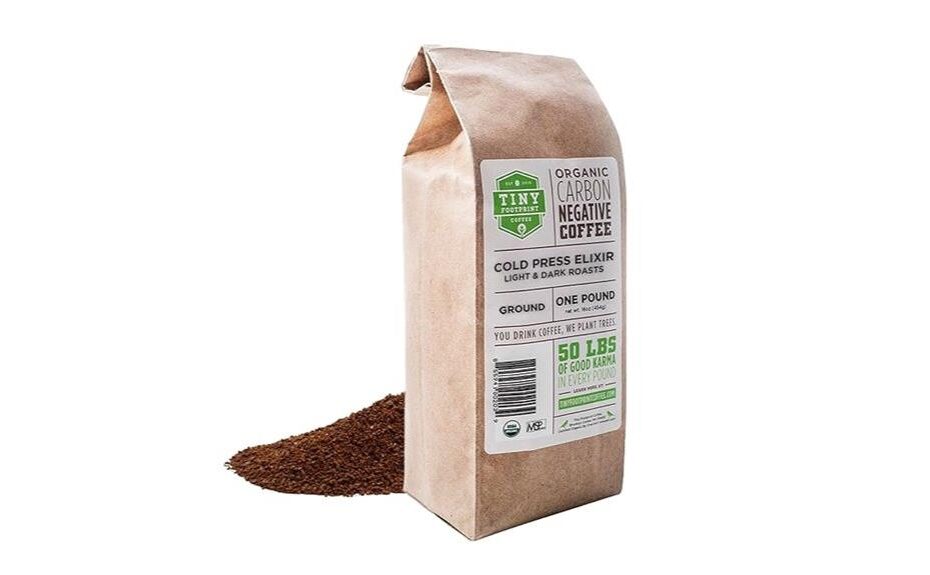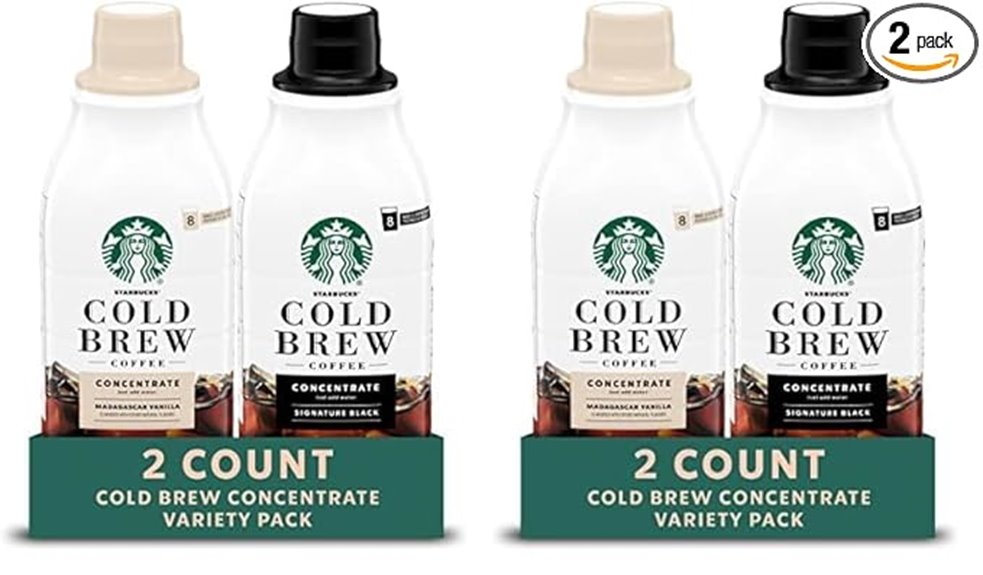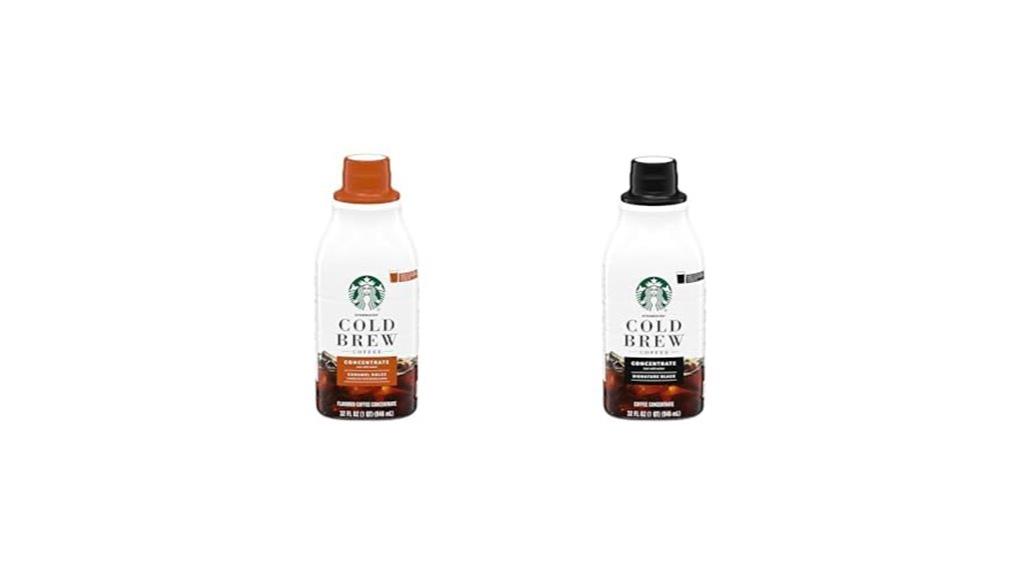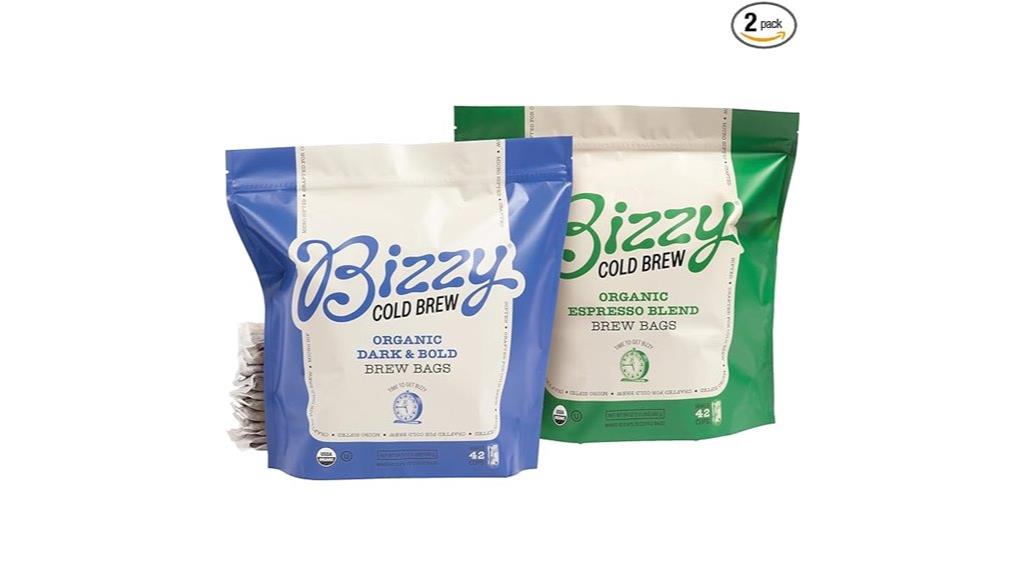






I've been exploring Tiny Footprint Coffee Cold Brew lately, and it's hard to ignore its unique blend of sustainability and flavor. The combination of light and dark roasts creates a surprisingly smooth profile with hints of fruit and cocoa, but there's more to it than taste. Its carbon-negative production and reforestation efforts make it a standout for eco-conscious drinkers. Still, I've noticed some inconsistencies in flavor that raise questions. If you're curious about how this cold brew stacks up against others or how to get the best results, there's plenty to unpack here. Let's see where this goes.
Key Takeaways
- Smooth, sweet flavor with floral and cocoa notes, ideal for cold brew enthusiasts.
- Carbon-negative production removes 54 lbs. of CO2 per pound, supporting eco-conscious consumers.
- Brews 1.35 gallons of cold brew per pound at a 1:6 ratio, diluted 1:1 for ready-to-drink smoothness.
- Ethically sourced, organic, and Fair Trade-certified, appealing to sustainability-focused buyers.
- Occasional bitterness and inconsistent flavor in some batches may affect overall satisfaction.
##
Tiny Footprint Coffee's cold brew blend combines light and dark roasts with Ethiopian coffees, creating a flavor profile that's both sweet and silky. The blend's complexity shines through with subtle notes of bright fruit, floral tones, and a cocoa-like body, making it ideal for cold brew enthusiasts. I've found that brewing techniques play a significant role in revealing its full potential—steeping for 16-18 hours at room temperature yields a balanced, rich flavor. The 1:6 brew ratio guarantees a concentrated base, which I dilute 1:1 for a smooth, ready-to-drink experience. The interplay of light and dark roasts adds depth, while the Ethiopian beans bring a vibrant acidity. It's a versatile blend that rewards patience and precision in brewing, delivering a consistently satisfying cup.
Features and Benefits
The blend of light and dark roasts, spiked with Ethiopian coffees, creates a uniquely balanced cold brew with sweet, silky richness and bright, floral notes. What sets this coffee apart is its carbon-negative production, removing 54 lbs. of CO2 per pound sold through reforestation efforts in Ecuador. It's a cup that not only tastes exceptional but also contributes to a healthier planet.
Blend of Light and Dark Roasts
Crafted with a unique blend of light and dark roasts, this coffee offers a harmonious balance that's perfect for cold brew. The roast balance creates a flavor complexity that's both rich and nuanced, blending the bright, fruity notes of light roasts with the deep, cocoa-like body of dark roasts. It's this interplay that makes each sip dynamic yet smooth, avoiding the bitterness often found in single-roast brews. The light roast brings a subtle floral brightness, while the dark roast grounds the flavor with a silky richness. Together, they deliver a cold brew that's layered, satisfying, and versatile—ideal for those who appreciate depth without sacrificing drinkability. It's a thoughtful blend designed to elevate your cold brew experience.
Ethiopian Coffee Blend for Cold Brew
Ethiopian coffee brings a distinctive character to this blend, infusing it with bright, fruity notes and floral undertones that shine in cold brew. The Ethiopian origin of these beans adds a layer of complexity, with its signature floral notes creating an invigorating and aromatic profile. When brewed cold, the blend's natural sweetness and silky texture are enhanced, making it smooth and easy to drink. The floral tones balance the cocoa-like body, offering a well-rounded experience that's both vibrant and mellow. I find this blend particularly appealing for its ability to highlight the unique qualities of Ethiopian coffee while maintaining a rich, satisfying finish. It's a perfect choice for those seeking a cold brew with depth and brightness.
Carbon-Negative Coffee Production
Beyond its vibrant Ethiopian-inspired flavors, this coffee stands out for its groundbreaking carbon-negative production. Tiny Footprint Coffee offsets 4 lbs. of CO2 per pound of coffee through carbon offset projects, ensuring it removes more emissions than it creates. Their sustainable farming practices, like shade-growing and organic certification, minimize environmental impact while supporting small, family-owned farms. By collaborating with Roastery 7 and the Mindo Cloudforest Foundation, they fund reforestation in Ecuador, which not only sequesters carbon but also restores ecosystems. This commitment to sustainability extends to their Minneapolis roastery, where they use fuel-efficient burners and biodegradable packaging. Drinking this coffee means I'm not just enjoying a rich, complex brew—I'm actively contributing to a healthier planet. It's a guilt-free indulgence that aligns with my values.
Reforestation Removes 54 Lbs. CO2
Reforestation plays a critical role in Tiny Footprint Coffee's carbon-negative mission, removing 54 lbs. of CO2 for every pound of coffee sold. I admire how their partnership with the Mindo Cloudforest Foundation in Ecuador focuses on planting native trees, which enhances carbon sequestration and combats climate change. The reforestation benefits go beyond CO2 removal; they restore essential ecosystems, support biodiversity, and protect water sources. It's inspiring to see a company not just offset emissions but actively reverse them. By choosing their coffee, I'm contributing to a cycle that prioritizes environmental restoration over mere sustainability. This approach guarantees that every sip supports a healthier planet. Tiny Footprint Coffee proves that impactful change is possible, blending ethical consumption with ecological stewardship.
Product Quality
When it comes to product quality, Tiny Footprint Coffee's cold brew blend stands out for its meticulous craftsmanship and exceptional flavor. The blend of light and dark roasts, spiked with Ethiopian coffees, delivers a sweet, silky richness with bright fruit and floral undertones. I've found its flavor consistency to be remarkable—every batch maintains that cocoa-like body and smooth finish. Its brewing versatility is another highlight; whether I'm using a French press, cold brew maker, or even a mason jar, the results are consistently balanced and vibrant. The small-batch roasting process guarantees freshness, and the organic, Fair Trade certification adds to its premium feel. It's clear that every step, from sourcing to roasting, is designed to preserve quality and elevate the cold brew experience.
What It's Used For
I use Tiny Footprint Coffee primarily for cold brew preparation, as its blend of light and dark roasts creates a smooth, rich flavor with fruity and floral undertones. It's perfect for enhancing my morning routine with an invigorating, non-bitter drink that's easy to make at home. Beyond taste, I appreciate its environmental impact, knowing each purchase supports reforestation and carbon-negative practices.
Cold Brew Preparation
With its blend of light and dark roasts spiked with Ethiopian coffees, Tiny Footprint Coffee is specifically crafted for cold brew, offering a sweet, silky richness with subtle notes of bright fruit, floral tones, and a cocoa-like body. To prepare, I use simple brewing techniques: a 1:6 coffee-to-water ratio, steeping the grounds in room-temperature water for 12-24 hours. This method extracts the coffee's full complexity without bitterness. I prefer a French press or a dedicated cold brew maker for easy filtration. The steeping methods are forgiving, allowing flexibility in time—shorter for lighter flavors, longer for deeper richness. Once steeped, I dilute the concentrate 1:1 with water or milk, depending on my preference. The result is a smooth, invigorating cold brew that highlights the coffee's unique profile.
Flavor Enhancement
For enhancing the flavor of cold brew, Tiny Footprint Coffee's unique blend of light and dark roasts, combined with Ethiopian coffees, creates a versatile base that adapts well to various additions. Its sweet, silky richness with bright fruit and floral undertones makes it ideal for flavor pairing with milk, cream, or plant-based alternatives. I've found that brewing techniques like adjusting the steep time (12-24 hours) or experimenting with dilution ratios (1:1 or 1:2) can highlight its cocoa-like body or bright acidity. Adding a splash of vanilla, cinnamon, or even a citrus twist complements its natural complexity. The blend's balance guarantees it doesn't overpower but enhances whatever you mix in, making it a standout choice for crafting personalized cold brew creations.
Environmental Impact
Tiny Footprint Coffee's environmental impact is rooted in its carbon-negative commitment, making it a standout in the coffee industry. For every pound of coffee sold, they offset 54 lbs. of CO2 through reforestation in Ecuador's Mindo cloud forest, far exceeding the 4 lbs. produced during roasting. Their carbon offset initiatives, in partnership with the Mindo Cloudforest Foundation, plant native trees that sequester carbon, restore ecosystems, and support biodiversity. Beyond this, they prioritize sustainable farming practices, sourcing shade-grown, organic, and Fair Trade-certified beans from small family farms. Their Minneapolis roastery also minimizes waste with biodegradable packaging and energy-efficient equipment. By choosing Tiny Footprint, I'm not just enjoying a great cold brew—I'm contributing to a healthier planet. It's coffee that tastes good and does good.
Product Specifications
Tiny Footprint Coffee's cold brew blend combines light and dark roasts, spiked with Ethiopian coffees, to create a unique flavor profile designed specifically for cold brewing. The coffee origin plays a key role here, with Ethiopian beans adding bright, fruity notes to the mix. The roast level balances light and dark, ensuring a smooth, rich body without overpowering bitterness. Here's a breakdown of its key specs:
| Attribute | Details |
|---|---|
| Roast Level | Light & Dark Blend |
| Coffee Origin | Ethiopian & Global Arabica |
| Brew Ratio | 1:6 (1:1 dilution) |
| Brew Yield | 1.35 gallons per pound |
This blend's versatility shines in cold brew, offering a silky, cocoa-like body with floral and fruity undertones. It's a thoughtful combination of roast levels and origins, crafted for an invigorating, balanced cup.
Who Needs This
Seeking a coffee that delivers both exceptional flavor and a positive environmental impact? Tiny Footprint Coffee is for coffee enthusiasts who crave a smooth, complex cold brew with notes of bright fruit, floral tones, and cocoa. It's also a must-try for eco-conscious consumers who prioritize sustainability. As the world's first carbon-negative coffee, it removes 54 lbs. of CO2 per pound sold through reforestation efforts. If you value shade-grown, organic, and Fair Trade-certified beans, this coffee aligns with your principles. Whether you're a cold brew aficionado or someone who wants to enjoy a guilt-free cup, this blend offers a unique combination of quality and responsibility. It's perfect for anyone who wants their coffee habit to leave a positive mark on the planet.
Pros
Diving into the pros, this coffee stands out for its exceptional flavor and environmental impact. The smooth flavor is a highlight, with a silky richness that's balanced by bright fruit and floral undertones. Its rich aroma is equally impressive, making every sip feel indulgent. Beyond taste, the carbon-negative commitment is a game-changer—it's invigorating to enjoy coffee that actively benefits the planet. Here's why I'm impressed:
- Smooth flavor: Sweet, chocolatey, and non-bitter, perfect for cold brew.
- Rich aroma: Inviting and complex, with floral and cocoa notes.
- Carbon-negative: Removes 54 lbs. of CO2 per pound sold.
- Ethical sourcing: Organic, Fair Trade, and shade-grown beans.
This coffee delivers on both taste and sustainability, making it a standout choice for conscious coffee lovers.
Cons
While this coffee excels in flavor and sustainability, it isn't without its drawbacks. I've noticed a few issues that might affect your experience, depending on your preferences. Here's what stood out to me:
- Bitter aftertaste: Despite its smooth profile, I occasionally detected a slight bitterness, especially when brewed longer than recommended.
- Inconsistent flavor: Some batches felt more vibrant, while others lacked the same depth, making it hit-or-miss.
- Price point: While the environmental impact is commendable, the cost might feel steep for those on a budget.
- Acidity: If you prefer low-acid coffee, the bright, fruity notes might not align with your taste.
These cons don't overshadow its strengths, but they're worth considering before committing.
What Customers Are Saying
Many customers rave about Tiny Footprint Coffee's cold brew, praising its smooth, mellow flavor and unique chocolatey richness with subtle berry undertones. I've noticed that customer satisfaction often hinges on flavor preferences, and this blend seems to hit the mark for those who enjoy a balanced, non-bitter profile. Reviews frequently highlight its silky texture and bright, fruity notes, which stand out compared to darker, more acidic roasts. Some even mention it's their go-to for converting non-coffee drinkers due to its approachable taste. While a few prefer stronger, bolder flavors, the majority appreciate its complexity and consistency. The environmental commitment also resonates deeply, adding to the overall appeal. It's clear this cold brew strikes a chord with those seeking both quality and sustainability.
Overall Value
Tiny Footprint Coffee's cold brew offers a compelling balance of quality and sustainability, making it a standout choice for eco-conscious coffee lovers. While the price may seem higher compared to conventional brands, its cost effectiveness becomes clear when you consider the yield—each pound brews 1.35 gallons of ready-to-drink cold brew. In a price comparison with artisanal brands like Coffee Bros, it holds its own, delivering exceptional flavor and ethical sourcing at a competitive rate. The carbon-negative commitment adds significant value, as each purchase supports reforestation and environmental restoration. For me, the combination of rich, smooth flavor, eco-friendly practices, and long-term savings makes it a worthwhile investment. It's not just coffee; it's a choice that aligns with both my taste buds and my values.
Tips and Tricks For Best Results
To get the most out of Tiny Footprint Coffee's cold brew, I've found that attention to detail in the brewing process makes all the difference. Start with a 1:6 coffee-to-water ratio, using 2/3 cup of grounds to 3 cups of water, and steep for 12-24 hours. For richer flavor, I extend the steep time closer to 24 hours. Experiment with brewing techniques like using a French press or a dedicated cold brew maker for easier filtration. To customize flavor, I adjust the dilution—less water for a bolder taste or more for a lighter, smoother profile. Storing the concentrate in a sealed container keeps it fresh, and I always use filtered water to avoid impurities. These small tweaks elevate the sweet, silky richness and bright fruit notes.
Conclusion
After exploring Tiny Footprint Coffee's cold brew, it's clear this product stands out for its unique blend of sustainability, flavor, and quality. The carbon-negative commitment and ethical sourcing practices set it apart, offering a guilt-free indulgence that supports reforestation and small-scale farmers. The flavor profile—sweet, silky, with bright fruit and cocoa notes—delivers a complex yet approachable experience, perfect for cold brew enthusiasts. While some may find it pricier, the sustainability benefits and environmental impact justify the cost. It's a coffee that not only tastes good but also does good, aligning with my values as a conscious consumer. For anyone seeking a smooth, ethically sourced cold brew, Tiny Footprint Coffee is a standout choice that balances taste and purpose beautifully.
Disclosure: As an Amazon Associate, I earn from qualifying purchases.



